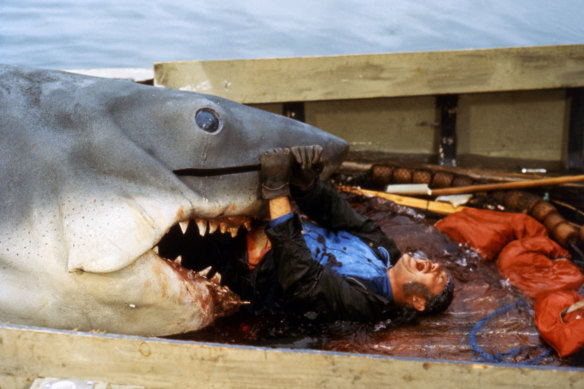A simple approach would be to strictly follow the Australian film classification guidelines and only allow my kids to view G- and PG-rated films. But even this isn’t a straightforward decision because, while there are legal restrictions around films with MA 15+, R 18+ and X 18+ ratings, films rated M are left to the discretion of parents and guardians.
However, according to experts, there are ways for parents to navigate beyond the classifications, while also protecting children from inappropriate or potentially harmful content. Derek McCormack, director of the Raising Children Network, believes it all comes down to research.

Actor Robert Shaw on the set of ‘Jaws’.Credit: Getty Images
Parents can do help make decisions around particular films by utilising online movie reviews from raisingchildren.net.au or Common Sense Media for in-depth information about the content, messages and characters in a movie they are considering for their children.
“The reviewers have expertise in child development and their reviews alert parents to themes or events to watch out for, as well as including suggestions for things to talk with their children about after watching the film,” McCormack says.
But as all parents know, kids won’t always ask before watching a movie. So, what happens if your pre-teen has watched a horror title without your permission? Should you be concerned? Well, depending on the specific content of the film and your child, the answer may be yes.
Loading
“When children – and adults for that matter – see something that evokes an emotional response, such as fear, horror or shock, it can repeatedly play back in their head, where they can recall and visualise the images and/or sounds that have traumatised them,” says Dr Lesley-Anne Ey, a senior lecturer in Education Futures at the University of South Australia.
In the case of a film like It, this could manifest with a fear of clowns, drains, showers and toilets, which can then lead to issues around hygiene, with avoidance of showering, or even toileting, says child psychologist and co-founder of Quirky Kids, Dr Kimberley O’Brien.
“If a child is afraid, they may [also] begin showing changes in behaviour, such as bed wetting, may show signs of separation anxiety, or be affected physically, for example, by becoming quite jumpy,” she says.
One of the main reasons pre-teen children can experience anxiety after watching a scary content is because of their inability to differentiate between what is real and what is not.
“Kids don’t often realise that a movie is make-believe – that it is make-up and costumes – so looking at the behind-the-scenes features of how the movie is made can be helpful if a child is showing any adverse effects of watching a certain film,” O’Brien says.
But the news is not all horrific (pun intended) because while some children may find the material of horror films unsettling, other kids (like gettymine) don’t. It’s this parental knowledge, along with research and classification advice, that is critical in deciding on whether a scary film is suitable for kids, regardless of their age.
“Ultimately parents should preview the film with their child in mind to identify whether they’re capable of understanding the content and whether the content may have a negative impact,” says Ey.
In the case of The Meg, while I don’t think a CGI Megalodon will cause my two daughters to be wary of jumping into the ocean this summer, Common Sense Media does recommend viewing for ages 14 and above. With that in mind, I may press pause on our cinema plans.
Make the most of your health, relationships, fitness and nutrition with our Live Well newsletter. Get it in your inbox every Monday.
For all the latest Life Style News Click Here
For the latest news and updates, follow us on Google News.
